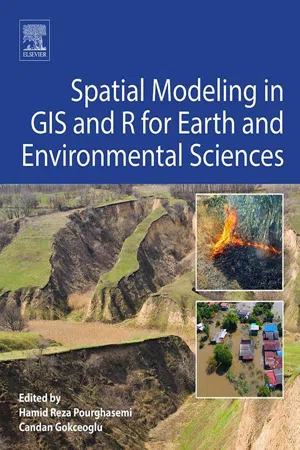
Spatial Modeling in GIS and R for Earth and Environmental Sciences
- 798 pages
- English
- ePUB (mobile friendly)
- Available on iOS & Android
Spatial Modeling in GIS and R for Earth and Environmental Sciences
About This Book
Spatial Modeling in GIS and R for Earth and Environmental Sciences offers an integrated approach to spatial modelling using both GIS and R. Given the importance of Geographical Information Systems and geostatistics across a variety of applications in Earth and Environmental Science, a clear link between GIS and open source software is essential for the study of spatial objects or phenomena that occur in the real world and facilitate problem-solving. Organized into clear sections on applications and using case studies, the book helps researchers to more quickly understand GIS data and formulate more complex conclusions.
The book is the first reference to provide methods and applications for combining the use of R and GIS in modeling spatial processes. It is an essential tool for students and researchers in earth and environmental science, especially those looking to better utilize GIS and spatial modeling.
- Offers a clear, interdisciplinary guide to serve researchers in a variety of fields, including hazards, land surveying, remote sensing, cartography, geophysics, geology, natural resources, environment and geography
- Provides an overview, methods and case studies for each application
- Expresses concepts and methods at an appropriate level for both students and new users to learn by example
Frequently asked questions
Information
Spatial Analysis of Extreme Rainfall Values Based on Support Vector Machines Optimized by Genetic Algorithms
The Case of Alfeios Basin, Greece
Abstract
Keywords
1.1 Introduction
Table of contents
- Cover image
- Title page
- Table of Contents
- Copyright
- Dedication
- List of Contributors
- 1. Spatial Analysis of Extreme Rainfall Values Based on Support Vector Machines Optimized by Genetic Algorithms: The Case of Alfeios Basin, Greece
- 2. Remotely Sensed Spatial and Temporal Variations of Vegetation Indices Subjected to Rainfall Amount and Distribution Properties
- 3. Numerical Recipes for Landslide Spatial Prediction Using R-INLA: A Step-by-Step Tutorial
- 4. Geospatial Multicriteria Decision Analysis in Forest Operational Planning
- 5. Parameter Optimization of KINEROS2 Using Particle Swarm Optimization Algorithm Within R Environment for Rainfall–Runoff Simulation
- 6. Land-Subsidence Spatial Modeling Using the Random Forest Data-Mining Technique
- 7. GIS-Based SWARA and Its Ensemble by RBF and ICA Data-Mining Techniques for Determining Suitability of Existing Schools and Site Selection of New School Buildings
- 8. Application of SWAT and MCDM Models for Identifying and Ranking Suitable Sites for Subsurface Dams
- 9. Habitat Suitability Mapping of Artemisia aucheri Boiss Based on the GLM Model in R
- 10. Flood-Hazard Assessment Modeling Using Multicriteria Analysis and GIS: A Case Study—Ras Gharib Area, Egypt
- 11. Landslide Susceptibility Survey Using Modeling Methods
- 12. Prediction of Soil Disturbance Susceptibility Maps of Forest Harvesting Using R and GIS-Based Data-Mining Techniques
- 13. Spatial Modeling of Gully Erosion Using Linear and Quadratic Discriminant Analyses in GIS and R
- 14. Artificial Neural Networks for Flood Susceptibility Mapping in Data-Scarce Urban Areas
- 15. Modeling the Spatial Variability of Forest Fire Susceptibility Using Geographical Information Systems and the Analytical Hierarchy Process
- 16. Prioritization of Flood Inundation of Maharloo Watershed in Iran Using Morphometric Parameters Analysis and TOPSIS MCDM Model
- 17. A Robust Remote Sensing–Spatial Modeling–Remote Sensing (R-M-R) Approach for Flood Hazard Assessment
- 18. Prioritization of Effective Factors on Zataria multiflora Habitat Suitability and its Spatial Modeling
- 19. Prediction of Soil Organic Carbon and its Mapping Using Regression Analyses and Remote Sensing Data in GIS and R
- 20. 3D Reconstruction of Landslides for the Acquisition of Digital Databases and Monitoring Spatiotemporal Dynamics of Landslides Based on GIS Spatial Analysis and UAV Techniques
- 21. A Comparative Study of Functional Data Analysis and Generalized Linear Model Data-Mining Techniques for Landslide Spatial Modeling
- 22. Regional Groundwater Potential Analysis Using Classification and Regression Trees
- 23. Comparative Evaluation of Decision-Forest Algorithms in Object-Based Land Use and Land Cover Mapping
- 24. Statistical Modeling of Landslides: Landslide Susceptibility and Beyond
- 25. Assessing the Vulnerability of Groundwater to Salinization Using GIS-Based Data-Mining Techniques in a Coastal Aquifer
- 26. A Framework for Multiple Moving Objects Detection in Aerial Videos
- 27. Modeling Soil Burn Severity Prediction for Planning Measures to Mitigate Post Wildfire Soil Erosion in NW Spain
- 28. Factors Influencing Regional-Scale Wildfire Probability in Iran: An Application of Random Forest and Support Vector Machine
- 29. Land Use/Land Cover Change Detection and Urban Sprawl Analysis
- 30. Spatial Modeling of Gully Erosion: A New Ensemble of CART and GLM Data-Mining Algorithms
- 31. Multihazard Exposure Assessment on the Valjevo City Road Network
- 32. Producing a Spatially Focused Landslide Susceptibility Map Using an Ensemble of Shannon’s Entropy and Fractal Dimension (Case Study: Ziarat Watershed, Iran)
- 33. A Conceptual Model of the Relationship Between Plant Distribution and Desertification Trend in Rangeland Ecosystems Using R Software
- Index